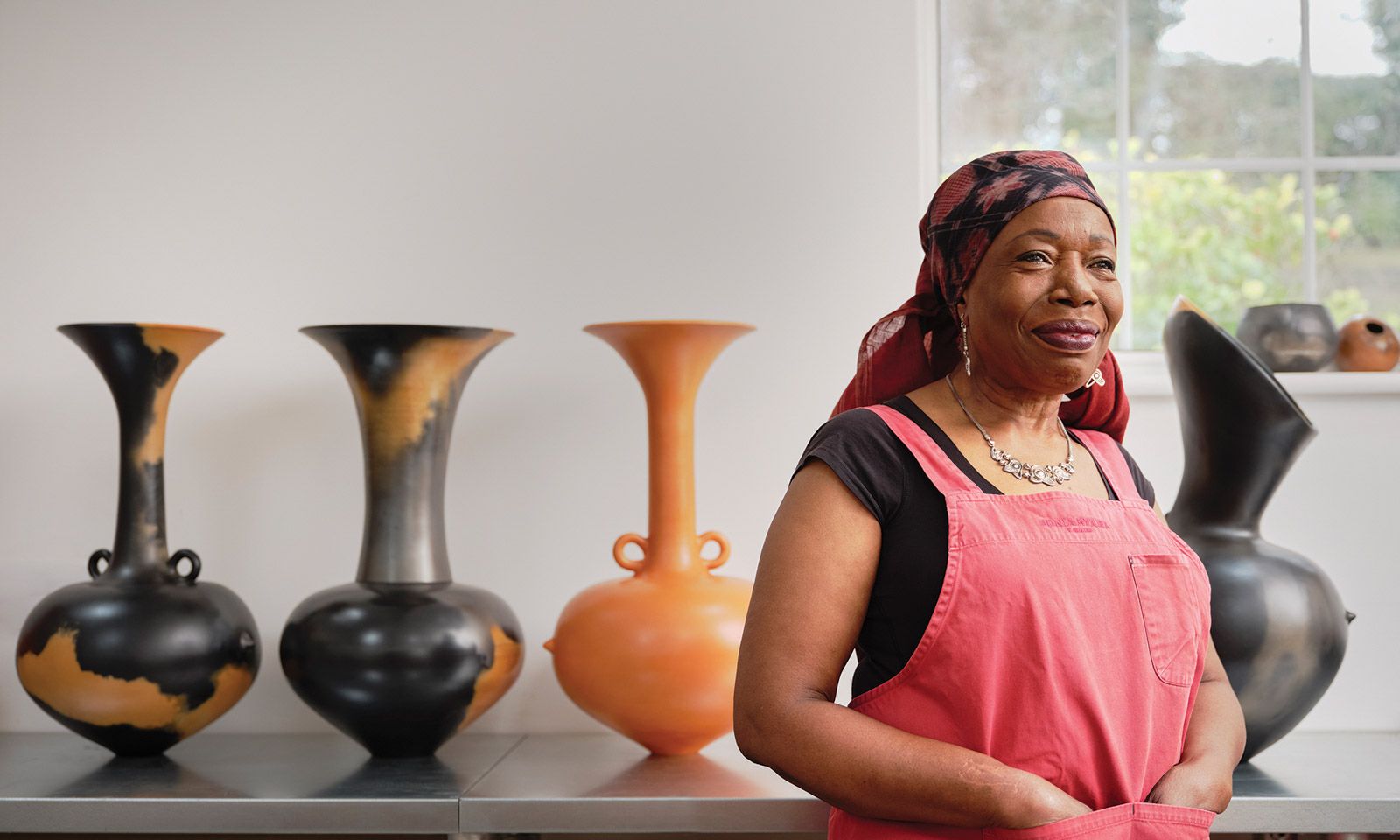Magdalene Odundo is currently showing her vessels at the Fitzwilliam Museum in Cambridge. She is also included in the upcoming exhibition Body Vessel Clay: Black Women, Ceramics & Contemporary Art at London’s Two Temple Place © Cristian Barnett
The Buck stopped here is a weekly blog by our contemporary art correspondent Louisa Buck covering the hottest events and must-see exhibitions in London and beyond
In the mid-1990s, when I was writing a book on the UK’s contemporary art scene for Tate, a curator at the gallery queried one of my artist entries: the then-barely known Grayson Perry. “Why are you including a potter?” asked the Tate grandee. “We didn’t commission a book about craft!” How times change. A few years later Perry won the Turner Prize and today ceramics are nearly as common as canvases in galleries and art fairs; this is certainly the case across the UK right now where artists from all generations and backgrounds are putting on shows to proclaim the power of clay.
Chief among them is Theaster Gates, who is currently staging a London ceramics takeover with a trio of exhibitions at the Whitechapel Gallery, White Cube in Mason’s Yard and the ceramics department at the Victoria and Albert Museum (V&A), all under the umbrella title of The Question of Clay. Clay will also feature in Gates’s forthcoming commission to create next year’s Serpentine Gallery pavilion. “Clay made me and is forever the root of my artistic interest,” says Chicago-based Gates, who took up pottery as a student at Iowa State University and then studied ceramics with master potters in Japan.
Theaster Gates's Afro-Ikebana (2019) combines pottery with Japanese tatami mats Photo: © Theo Christelis/White Cube; © Theaster Gates
At the Whitechapel, Gates combines his own work made over two decades with a condensed and critical history of ceramics, from Han dynasty storage jars to vessels by the late 20th-century potters Bernard Leach and Lucie Rie. Also included are less exalted examples of the medium, ranging from a pallet of humble bricks to a grim array of slavery-era tobacco jars, and more recent caricatured racist ornaments. Gates’s own work spans his earliest hand thrown pots to the most recent large-scale pieces which he describes as Afro-Mingei, and in which he fuses traditional Japanese craft with African American aesthetics and culture. Adding additional context is a new film featuring Gates in an abandoned brick factory in Montana, interwoven with vocal solos by the artist and his musical group the Black Monks, along with archive footage taken from throughout his career.
The companion piece to this film is being exhibited at White Cube and shows Gates singing an improvised hymn in the same brickworks, where on a nearby residency he made the numerous thrown vessels that dominate this show. These modest but exquisite pots are grouped on top of rows of wooden filing cabinets where more little vessels nestle inside; contrasting this domestic display are Gates’s Brick Paintings: wall-based ceramic panels that treat clay as canvas and further blur boundaries between art and craft.
Ceramics were also on display at Frieze London last month, courtesy of the young British artist Lindsey Mendick, whose cluster of nine large, darkly subversive vases with octopus tentacles erupting suggestively from their interiors were shown by Carl Freedman Gallery. “I resolutely wanted myself to be within the clay—making with clay grounds you in that particular time,” Mendick says. She especially enjoys toying with the art-craft divide and undermining ideas of the functional object. “Ceramics are meant to be perfect, not in a state of flux,” she says. More of her work, including horned and claw-footed planters, a pair of ceramic stilettos and a china scorpion on a diamante leash can be seen in PROUDICK at London’s Hannah Barry Gallery, a show made in collaboration with Paloma Proudfoot. Here clay plays a major part in their exploration of teenage libidinal fantasies and voyages of self discovery.
More slow-burning with their provocative associations are the distinctive, full-bellied pots of the Nairobi-born, Surrey-based Magdalene Odundo, who is currently showing her vessels alongside works from various UK museum collections at the Fitzwilliam Museum in Cambridge. Typically inspired by her extensive travels and research into craft tradition, the works are painstakingly built up in coils and sprout suggestive nodules while their surfaces are repeatedly fired to achieve a rich, burnished texture. Odundo, who has done so much to erode boundaries between art and craft, has been firmly in the art camp since her major touring shows at Hepworth Wakefield and the Sainsbury Centre in 2019. She is also included in one of the most eagerly anticipated exhibitions of next year: Body Vessel Clay: Black Women, Ceramics & Contemporary Art, which opens in January at Two Temple Place in London and explores how ceramics have been disrupted and reimagined by Black women over the past 70 years. For, as Odundo says, of all the mediums available to artists, “clay is the most versatile and pliable and naturally earthy, sympathetic and human”.
• Theaster Gates: Slight Intervention #5, until 9 January 2022, at the Victoria and Albert Museum; A Clay Sermon, until 9 January 2022, at Whitechapel Gallery; Oh, The Wind Oh, The Wind, until 30 October, at White Cube, Mason’s Yard
• PROUDICK, until 6 November, at Hannah Barry Gallery, London
• Magdalene Odundo, until 24 July 2022, at the Fitzwilliam Museum, Cambridge

